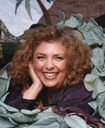People are interested in knowing about you and how you got to where you are now as an artist. There will be the odd occasion when you need to provide information about yourself to a group to whom you are lecturing. When part of an exhibition, a biography is sometimes requested. Some art consultants request a biography as a matter of course. In sending out a press release on your work, a bio can be very handy—especially if you're running about at the last-minute!
I find that most people already have a biography if they have an already-written artist's statement; they have mistakenly combined statement and biography. This needs to be separated out—anytime you state a fact, it's probably bio-material.
Starting to Write Your Biography
If you're having trouble getting started, kickstart your biography by writing your résumé in prose form. Once you're comfortable, edit out the bits that do belong in a résumé and leave in the personal items about yourself.
Ask Yourself…
How old are you? Where were you born? When were you born? In what time period if you prefer not to mention a particular date. When did you start doing artistic things? What compelled you to create? Was it hard? Did you just drift into it?
Have you had any art education—formally or informally? Influences include your childhood, the places you've lived or traveled, reading, other artists' work…
Focus on the art in your life. What inspires you? What would you like people to know about you? What influences you to create—no why's—that belongs in your artist's statement! How, in life, do you express yourself artistically? How did you get started? When? Was it hard? Did you just drift into it?
What kind of art education have you had—formally or informally? Where have you lived or traveled and how has it influenced you? People want to know about you and how you got to where you are now as an artist.
Where you were born is important because it gives people a handle to grasp. One that tells them what your childhood might have been like. The time period of your childhood also tells what outside influences might have had a bearing on your mental outlook.
Your experiences with or without a formal education are similarly inspiring. Influences include your childhood, the places you've lived or traveled, reading, other artists' work. Think of what you'd do with your life if art were taken away. Where would your need express itself? What makes you want to do the creating you do? What other passions or hobbies do you have in your life? Are they a creative outlet of some kind? How do you find the time to create your art? When do you create? Do you have children? How do the kids relate to your art? Think of the most common questions people have asked you in the past?
Have you received any awards or degrees? In what important national shows have you exhibited? Have you shown in galleries or museums? With non-fiber artists? Has your work appeared in any publications? Have you published anything? Do you teach? What do you teach?
How Long is a Biography?
A biography should be one page OR LESS in length. It's not necessary to get into a detailed explanation of influences or travels; a general statement is enough unless it was an extraordinary experience, which you want to highlight (briefly). Avoid being boring and leave unrelated items out. Ask a friend to critique it for you. Most important, think about how long you want to stand in front of an audience while someone introduces you!
If you already have a biography, sit down with a friend and ask them to critique it.
KD Did It will work with you.

Kathy Davie is an editor, author, and artist with degrees in Technical Writing & Editing, Digital Media, and History from Metropolitan State College in Denver, Colorado.
A huge believer in knowledge being power, Kathy has an ongoing and free set of Author Tools for authors interested in self-editing with an ongoing series of posts on Word Confusions, what’s Properly Punctuated, those tricky Formatting Tips, and the sleep-inducing Grammar Explanations. There is also an online tutorial on Using Microsoft Word’s Markup Tool.
And if you get too sleepy, explore KD Did It for various writing and editing services.

Leave a Reply